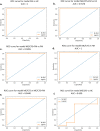Circulating microRNA expression signatures accurately discriminate myalgic encephalomyelitis from fibromyalgia and comorbid conditions
- PMID: 36732593
- PMCID: PMC9894933
- DOI: 10.1038/s41598-023-28955-9
Circulating microRNA expression signatures accurately discriminate myalgic encephalomyelitis from fibromyalgia and comorbid conditions
Abstract
Myalgic encephalomyelitis/chronic fatigue syndrome (ME/CFS), and fibromyalgia (FM) are two chronic complex diseases with overlapping symptoms affecting multiple systems and organs over time. Due to the absence of validated biomarkers and similarity in symptoms, both disorders are misdiagnosed, and the comorbidity of the two is often unrecognized. Our study aimed to investigate the expression profiles of 11 circulating miRNAs previously associated with ME/CFS pathogenesis in FM patients and individuals with a comorbid diagnosis of FM associated with ME/CFS (ME/CFS + FM), and matched sedentary healthy controls. Whether these 11 circulating miRNAs expression can differentiate between the two disorders was also examined. Our results highlight differential circulating miRNAs expression signatures between ME/CFS, FM and ME/CFS + FM, which also correlate to symptom severity between ME/CFS and ME/CFS + FM groups. We provided a prediction model, by using a machine-learning approach based on 11 circulating miRNAs levels, which can be used to discriminate between patients suffering from ME/CFS, FM and ME/CFS + FM. These 11 miRNAs are proposed as potential biomarkers for discriminating ME/CFS from FM. The results of this study demonstrate that ME/CFS and FM are two distinct illnesses, and we highlight the comorbidity between the two conditions. Proper diagnosis of patients suffering from ME/CFS, FM or ME/CFS + FM is crucial to elucidate the pathophysiology of both diseases, determine preventive measures, and establish more effective treatments.
© 2023. The Author(s).
Conflict of interest statement
A.M. is Director of Interdisciplinary Canadian Collaborative Myalgic Encephalomyelitis (ICanCME) Research Network, a national research network funded by The Canadian Institutes of Health Research (grant MNC—166142 to A.M.) and a Member of the Scientific Advisory Board of the Open Medicine Foundation.
Figures






References
-
- Carruthers BM, et al. Myalgic encephalomyelitis/chronic fatigue syndrome: Clinical working case definition, diagnostic and treatment protocols. J. Chronic Fatigue Syndr. 2003;11:7–115.
Publication types
MeSH terms
Substances
LinkOut - more resources
Full Text Sources
Medical

